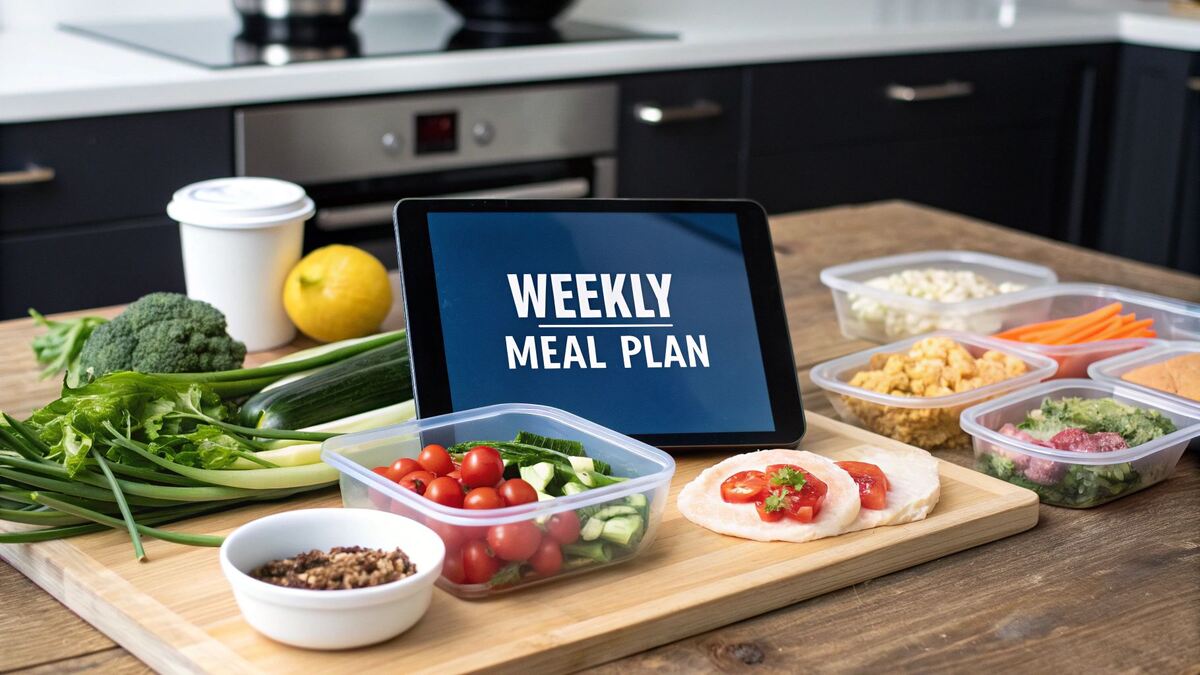Weekly Meal Plans for Healthy Eating Made Simple
If you’re tired of the daily 5 PM scramble, wondering "what's for dinner?" then you’ve come to the right place. A weekly meal plan is more than just a schedule; it's a game-changer for anyone serious about healthy eating. It helps you ditch the decision fatigue, sidestep the siren call of takeout, and finally take the driver's seat on your nutritional journey.
Why Meal Planning Is Your Secret Weapon for Healthy Eating
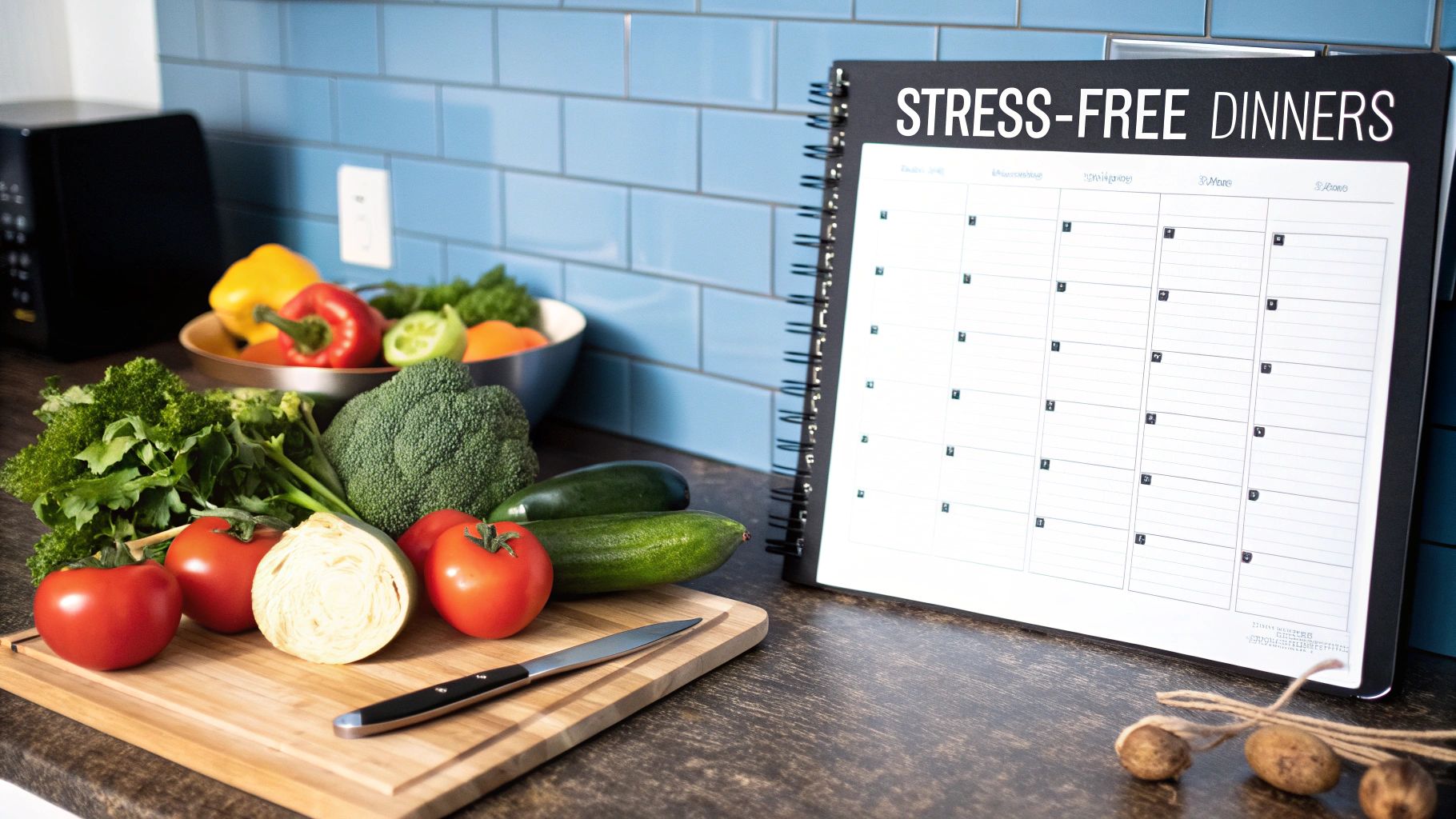
Think of meal planning less like a rigid diet and more like building a system that makes good choices feel automatic. Picture this: instead of staring into a half-empty fridge at the end of a long day, you know exactly what’s on the menu and have everything you need. That one simple shift has a massive ripple effect on your entire week.
The benefits go far beyond just saving time. Research consistently shows that people who plan their meals tend to eat a more nutritious, higher-quality diet. They also save a surprising amount of money at the grocery store by cutting out impulse buys and—my personal favorite—drastically reducing food waste. Every single ingredient has a job to do.
The Four Pillars of Effective Meal Planning
Over the years, I've found that successful meal planning really boils down to four key pillars. When you get these right, what feels like a chore at first becomes a sustainable, almost effortless habit. Each one builds on the last, creating a smooth process from idea to dinner table.
This simple framework provides the structure you need to stay on track.
| Pillar | What It Involves | Key Benefit |
|---|---|---|
| Set Your Intention | Defining your personal 'why,' like boosting energy or managing weight. | Creates clear direction and keeps you motivated. |
| Build a Smart Plan | Mapping out meals for the week and picking recipes you'll actually enjoy. | Wipes out daily stress and reactive food choices. |
| Shop with Purpose | Creating a precise grocery list directly from your weekly meal plan. | Saves money, cuts food waste, and gets you in and out of the store faster. |
| Prep for Success | Prepping ingredients or full meals ahead of time. | Makes healthy eating the easiest option on your busiest days. |
Ultimately, this isn't just about organizing your kitchen—it's about transforming your relationship with food. It replaces chaos with calm. If you're looking for inspiration to get started, checking out a balanced meal plan can give you a great foundation to build upon.
The real magic of meal planning isn't just in the food itself; it's in reclaiming your time and mental energy. By making decisions ahead of time, you free up cognitive resources during your busiest moments, making healthy choices the path of least resistance.
Setting Goals That Actually Guide Your Meal Plan
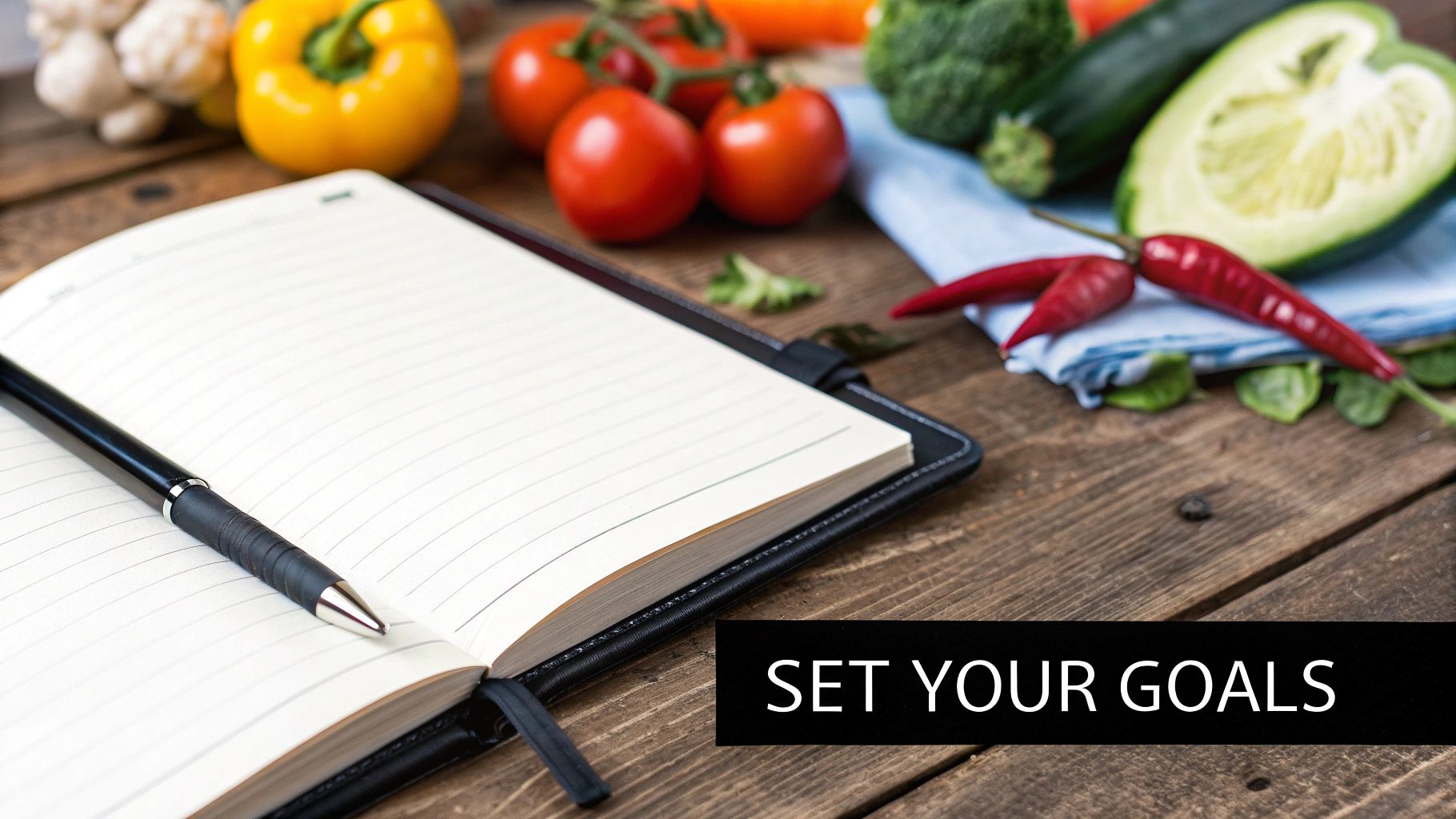
Before you even glance at a recipe, we need to talk about your "why." I've seen it time and time again: people jump straight to the food without figuring out what they're trying to accomplish. A goal like "eat healthier" sounds good, but it's so vague it’s practically useless. It gives you no direction, and you'll be back to square one by Wednesday.
A truly effective meal plan starts with a clear destination. Are you an athlete trying to fuel peak performance, or are you a busy parent just trying to survive the 3 p.m. energy crash? The food you need for those two goals is completely different.
Your meal plan isn't just a list of foods; it's a personalized tool designed to help you achieve a specific outcome. Without a clear goal, you’re just cooking—not planning with purpose.
Define Your Primary Objective
Okay, let's get specific. What's the one thing you want this meal plan to do for you? By zeroing in on a single primary goal, you avoid getting overwhelmed and can make much clearer choices.
Think about which of these scenarios feels most like you:
- Muscle Gain: Here, your focus will be on packing in the protein and timing your carbs around workouts. Your plan would be full of things like lean meats, eggs, and complex carbs like quinoa.
- Sustained Energy: To avoid that afternoon slump, you'll need balanced meals loaded with fiber, protein, and healthy fats to keep your blood sugar stable. Think salmon with roasted veggies or chicken fajita bowls with brown rice.
- Managing Dietary Needs: If you're dealing with something like a gluten intolerance or a dairy sensitivity, your main goal is simply to feel good and avoid symptoms. The entire plan is built around safe, nourishing alternatives.
- Weight Management: This usually means focusing on nutrient-dense foods that are lower in calories, along with paying attention to portion sizes. Salads topped with grilled chicken, hearty vegetable soups, and lean protein with a side of steamed greens will become your go-to meals.
Once you’ve identified your main objective, you have a filter. Suddenly, you can look at any recipe and know instantly whether it helps you get where you want to go.
Consider Your Real-Life Constraints
A beautiful plan on paper means nothing if it doesn't work in the real world. This is where you need to be brutally honest with yourself. Your schedule, your budget, and even how much you enjoy cooking will make or break your ability to stick with this.
Ask yourself a few practical questions:
- How much time can you actually spend cooking? If you only have 20-30 minutes on a Tuesday night, one-pan dinners and slow-cooker recipes are going to be your saviors. Save the fancier stuff for the weekend.
- What’s your weekly food budget? This dictates whether you're buying chicken thighs or filet mignon. It also helps you lean on affordable workhorses like beans, lentils, and seasonal produce.
- Who else are you feeding? A meal plan for a single person is worlds apart from one for a family with picky eaters. For families, I always recommend "build-your-own" nights—think taco bars or pasta stations—so everyone can customize their plate.
A busy parent might plan for "Meatball Thursday," using frozen meatballs and a jar of good sauce for a quick, kid-friendly win. On the other hand, a fitness buff might spend Sunday afternoon grilling a week's worth of chicken breasts and roasting sweet potatoes. Both are great plans because they fit the person's life.
Personalize Your Flavor Profile
This last part is critical: you have to actually like the food you’re eating. Forcing down bland chicken and broccoli every night is the fastest route to a pizza delivery. A sustainable plan has to be delicious.
What flavors do you genuinely crave? Spicy Thai curries? Hearty Italian pasta? Fresh Mediterranean salads? Build your plan around those tastes.
- Love Mexican food? Make room for burrito bowls with all the fixings.
- Enjoy Asian flavors? A simple stir-fry with tofu or shrimp and a bunch of colorful vegetables can be on the table in under 20 minutes.
- Need comfort food? Try a healthier shepherd's pie using a cauliflower mash topping instead of potatoes.
When you align your health goals with your real-world schedule and the flavors you love, you've created more than just a diet. You've built a personal roadmap that makes sense for your life. That's the secret to making a meal plan stick.
Building Your Personal Recipe Collection
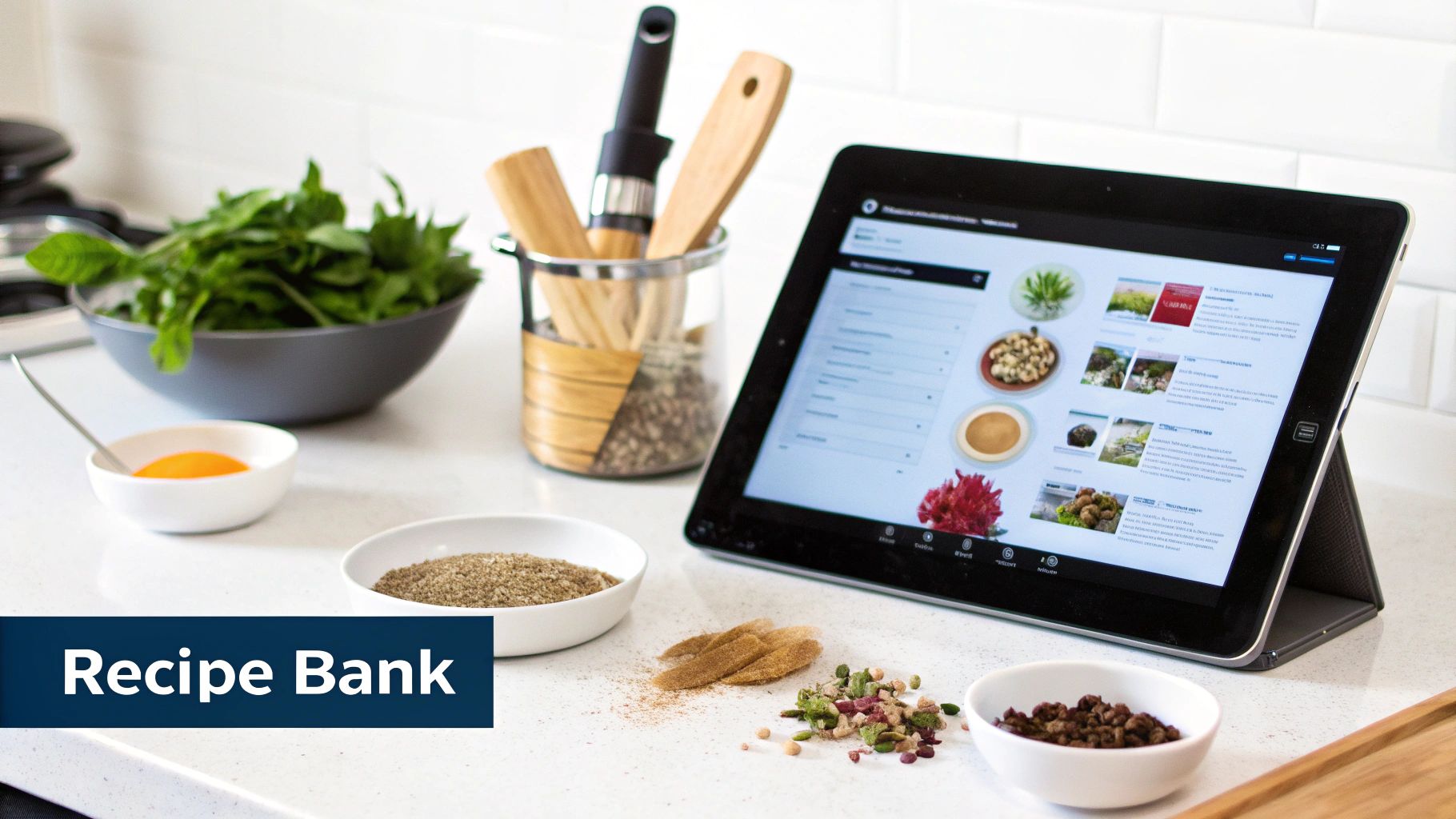
This is where meal planning stops being a chore and actually becomes fun. A truly great weekly plan isn’t about chasing down seven brand-new, complicated recipes every single week. That’s a recipe for burnout. Instead, it’s built on a solid foundation of meals you genuinely love and can cook with confidence.
The idea is to build your own personal "recipe bank"—a go-to collection that makes planning feel less like starting from scratch and more like picking from a menu of your greatest hits. It’s the difference between having a real strategy and just having a random list of groceries.
Curating Your Go-To Recipes
First things first, think about the meals you already know and love. What are the dishes that are pure comfort? Maybe it's your grandmother's spaghetti sauce, a simple roast chicken you've perfected, or your foolproof taco night setup. These are your "anchor meals," and they're the heart of your collection.
With a few favorites in hand, you can start to branch out—but do it strategically. I always recommend introducing just one or two new recipes a week. This keeps things from getting stale without overwhelming you. Try that new recipe on a Sunday afternoon when you have more time, not on a chaotic Tuesday night.
A great recipe bank is like a great wardrobe. It has reliable classics you can always count on, mixed with a few new, exciting pieces that keep things fresh. The key is balance, not overwhelming yourself with too many choices.
This slow-and-steady approach is what makes healthy eating sustainable. You’ll gradually build an amazing collection of meals you feel good about making and eating.
A Smart System for Organization
Let’s be honest: a chaotic mess of bookmarks, screenshots, and saved pins is just as useless as having no plan at all. A good recipe bank needs a simple, functional system so you can find what you need in seconds.
Here’s a practical way I like to categorize recipes:
- By Protein: Grouping recipes by their core protein (Chicken, Beef, Fish, Beans/Tofu) is a brilliant way to ensure you're getting variety. If you're looking for more plant-based ideas, our guide to vegetarian meal planning has tons of inspiration.
- By Cooking Time: This is an absolute lifesaver. Create categories like "Under 30 Minutes," "One-Pan Meals," or "Slow Cooker." When you know you have a crazy-busy day coming up, you can jump right to your quick-win options.
- By Meal Type: The basics are essential for a reason. Keeping Breakfast, Lunch, Dinner, and Snacks separate helps you build out a full day's plan without overthinking it.
You don't need complicated software. A simple notes app on your phone or even a physical binder with dividers can work wonders. The best system is always the one you'll actually stick with.
The Art of Overlapping Ingredients
This is my favorite part—where you really start to feel like a pro. The biggest win in meal planning is making your ingredients pull double-duty. It's the secret to slashing food waste and making your grocery budget go further. You have to start looking at your week as a whole, not just seven individual days.
For example, a big bag of spinach can be a hero ingredient all week long:
- Monday: Toss a handful into your morning smoothie.
- Wednesday: Sauté it with garlic as a quick side for some salmon.
- Friday: Use it as the base for a big grilled chicken salad.
This simple shift in thinking completely changes how you build your grocery list. Instead of buying a dozen hyper-specific ingredients for each recipe, you start to focus on versatile staples you can mix and match.
| Ingredient | Meal 1 | Meal 2 | Meal 3 |
|---|---|---|---|
| Rotisserie Chicken | Chicken Fajita Bowls | Buffalo Chicken Salad | Quick Chicken Noodle Soup |
| Bell Peppers | Sautéed for Fajitas | Raw in a Cobb Salad | Roasted with Sausage |
| Canned Black Beans | Added to Fajita Bowls | Blended into a Black Bean Burger | Side Dish with Rice |
| Cilantro | Topping for Fajitas | Mixed into Guacamole | Garnish for Soup |
Thinking this way takes a little practice, but the payoff is huge. Your fridge will be less cluttered, your grocery bill will shrink, and you'll be amazed at how little food you throw away. This is the kind of efficiency that makes healthy eating feel effortless and sustainable for the long haul.
Using Digital Tools to Streamline Your Planning
Let’s be honest: manually browsing for recipes, scribbling down shopping lists, and trying to track your macros can feel like a part-time job. This is where technology becomes your best friend. The right digital tool can take all the tedious, repetitive parts of meal planning off your plate, turning a weekly chore into a quick and surprisingly satisfying task.
You're not alone in looking for a better way. The digital meal planning space has exploded recently as more of us try to get organized with our health. In fact, trends show that by 2025, over 67% of adults between 25 and 45 will be using meal planning or grocery list apps at least twice a week. It’s a clear sign that people are moving toward more intentional eating habits, and you can explore more about these app trends to see what’s driving the shift.
Choosing the Right Type of App
Not all meal planning apps are built the same. They generally fall into a few different buckets, and knowing the difference is the key to finding something that actually fits into your life instead of becoming just another notification you swipe away.
Here’s a quick rundown of what you’ll find out there:
All-in-One Meal Planners: Think of these as the command centers of meal planning. Apps like Paprika or Plan to Eat let you grab recipes from anywhere online, drag them onto a calendar, and instantly generate a categorized shopping list. They’re incredibly efficient but often come with a subscription fee and a bit of a learning curve.
Recipe Discovery & Planning Apps: If you're stuck in a food rut, this is your category. Platforms like Yummly or Mealime are brilliant for finding new meals that match your diet and preferences. Their planning features can sometimes be a little less powerful, but they're fantastic for inspiration.
Simple List-Making Apps: Sometimes, simple is better. A tool like AnyList or even the notes app on your phone can work wonders. You won’t get any automation—you’ll have to type out every ingredient yourself—but these apps are typically free, dead simple to use, and easy to share with your partner or family.
The best tool is the one you will consistently use. Don't pay for an all-in-one planner with features you'll never touch if a simple, free list app is all you need to stay organized and on track.
Features That Make a Real Difference
When you start comparing apps, it’s easy to get bogged down in a long list of shiny features. In my experience, only a handful of them truly change the game for your weekly routine.
First, look for a "recipe clipper" or browser extension. This is a non-negotiable for me. It lets you save a recipe from any food blog or website with a single click, pulling the ingredients and instructions directly into your app. No more copying and pasting.
Next is a smart grocery list. A good app won't just give you a random list of ingredients. It consolidates them. If three of your recipes call for onions, your list should simply say "Onions: 3," not list it three separate times. Bonus points if it automatically sorts items by grocery store aisle (produce, dairy, pantry) to make your shopping trip faster.
Finally, you need flexibility and customization. Life happens. Your meal planner should be able to roll with the punches. The ability to easily drag and drop meals to different days, add notes about leftovers, or scale a recipe from two servings to four is what makes a digital plan work in the real world.
By focusing on a tool with these core functions, you’re not just downloading an app—you're building a system that actually supports your goals and makes healthy eating feel like a natural part of your life.
Mastering the Art of Smart Meal Prep
A great plan on paper is just that—a plan. The real magic happens when you bring your weekly meal plans for healthy eating to life in the kitchen. This is where we shift from theory to action, turning a bit of prep work into a rewarding ritual that makes your entire week run smoother.
Think of it this way: a couple of hours invested on a Sunday pays dividends every single day. The process doesn't even start with chopping vegetables; it begins with a smarter way to shop.
From Plan to Pantry: The Strategic Grocery Run
Forget aimlessly wandering the aisles. The goal is to get in, grab what you need, and get out with zero stress. The secret? Organize your grocery list based on the store's layout, not just by recipe. It’s a simple tweak that saves so much time.
Here's a tried-and-true method for structuring your list:
- Produce First: Head to the produce section as soon as you walk in. Grab all your fresh fruits and veggies. Tackling this first means your frozen and refrigerated items won't be sitting in your cart getting warm.
- Proteins and Dairy Next: Swing around the perimeter of the store. This is typically where you’ll find the meat counter, seafood, and dairy cases. Pick up your chicken, fish, eggs, yogurt, and milk here.
- Dry Goods and Pantry Staples Last: Finally, it's time for the center aisles. Weave through to get your canned goods, grains like quinoa and rice, spices, and oils.
This logical flow cuts down on backtracking and keeps those impulse buys in check. You're not just shopping; you're on a mission.
Choosing Your Meal Prep Style
Let's be clear: there's no single "right" way to meal prep. Your schedule, your energy levels, and your personal preferences all play a role. The key is finding a rhythm that genuinely makes your life easier.
Maybe you love dedicating a few hours on a Sunday to batch-cook everything. Or perhaps smaller, 20-minute prep sessions each evening work better for you. Both are valid.
The most effective meal prep strategy is the one you can actually stick with. Whether you're cooking full meals ahead of time or just pre-chopping onions, the goal is to do the heavy lifting upfront so weeknight cooking feels effortless.
This infographic breaks down the essential workflow, from building that smart shopping list to storing your prepped food for maximum freshness.
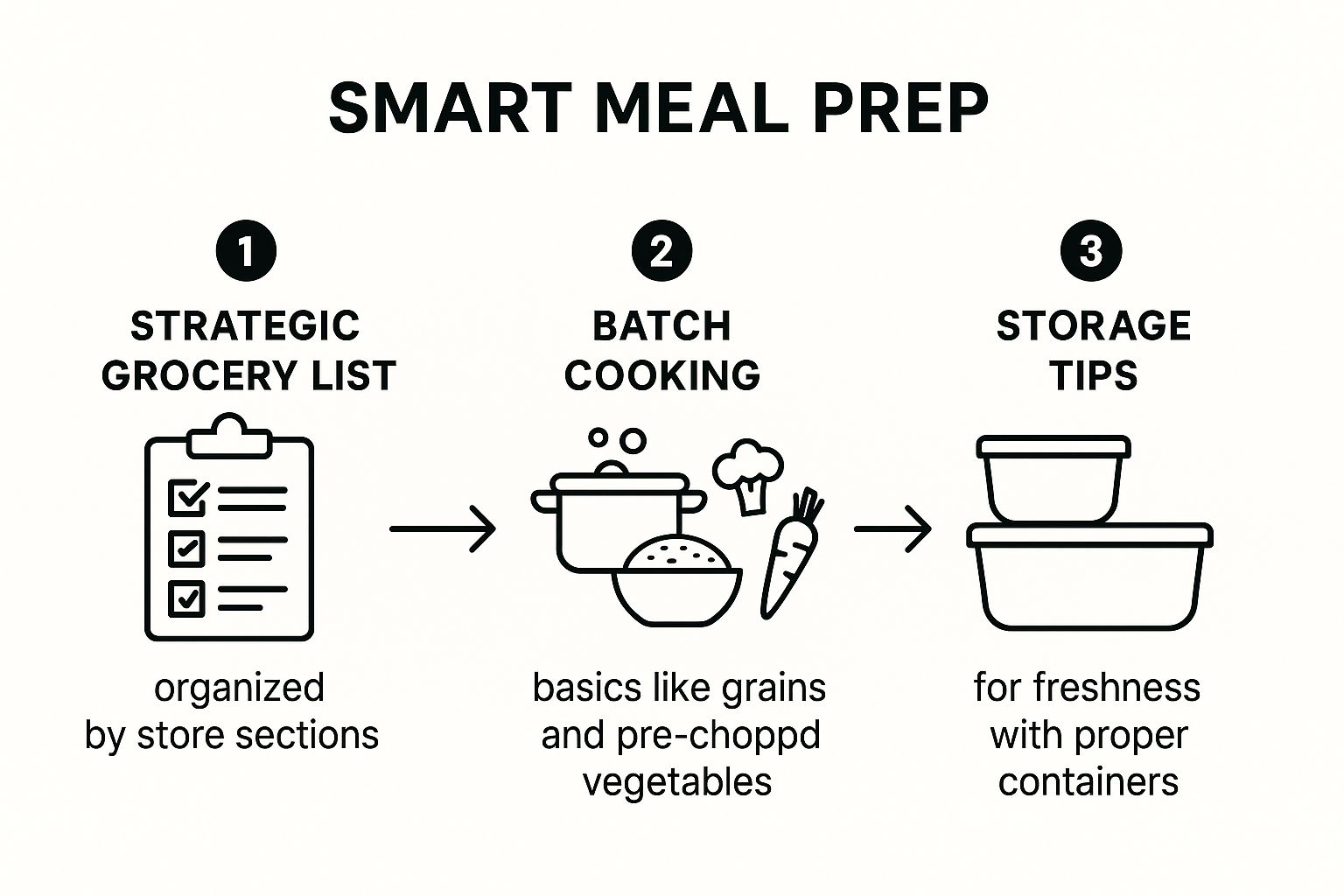
As you can see, these three stages—shopping, prepping, and storing—create a sustainable cycle that keeps your healthy eating goals on track without the daily grind.
A Sample Sunday Prep Workflow
Let me walk you through a realistic two-hour prep session that can set you up for a week of success. We're not cooking seven gourmet dinners here. Instead, we're creating versatile components you can mix and match for quick, healthy meals.
Hour 1: The Foundation
- Get the Grains Going: Start by getting a pot of quinoa or brown rice on the stove. This is a set-it-and-forget-it task that frees you up to do other things.
- Roast Your Veggies: While the grains cook, chop up hardy vegetables like broccoli, bell peppers, and sweet potatoes. Toss them with a bit of olive oil and your favorite seasonings, then get them roasting on a baking sheet.
- Prep Raw Ingredients: Now, tackle the fresh stuff. Wash and chop salad greens, slice cucumbers, and dice an onion. Store them in separate airtight containers so they're ready for salads and stir-fries.
Hour 2: Proteins and Assembly
- Cook Your Protein: This is a good time to grill or bake a batch of chicken breasts or marinate some tofu. You could also hard-boil a half-dozen eggs for easy snacks or salad toppers.
- Portion and Store: Once everything is cooked and cooled, it's time to assemble. Portion the grains, roasted veggies, and protein into individual containers for grab-and-go lunches. One of my go-to combos is grilled chicken, roasted broccoli, and quinoa—it’s a balanced, high-protein meal that never fails. For more ideas built around this component-style cooking, a good Mediterranean meal plan offers fantastic inspiration.
- Clean as You Go: Seriously, don't skip this. Washing dishes and wiping down counters as you work makes the whole process feel less overwhelming.
Pro Tips for Food Storage and Safety
All your hard work preparing food is only as good as how you store it. Proper storage is what keeps your food fresh, delicious, and safe to eat all week long.
I highly recommend using clear, airtight containers. Glass ones are a great investment because they don't stain or hold onto smells, and they can go straight from the fridge to the microwave. Labeling your containers with the contents and the date is another small step that makes a huge difference in keeping your fridge organized.
If you want to get serious about food safety, it’s worth understanding the basics of HACCP food safety principles. This will give you professional-level insight into how to properly cool, store, and reheat your prepped meals, ensuring everything stays safe and tasty.
Common Questions About Weekly Meal Planning
Even the most seasoned meal planners hit a wall sometimes. Life throws a curveball, your motivation takes a nosedive, or a carefully crafted plan gets derailed by a last-minute dinner invitation. That’s not a failure; it’s just life. The secret isn’t a rigid, unbreakable plan, but a flexible system that can roll with the punches.
Let's dig into some of the most common questions and hurdles people run into. Think of this as your field guide to navigating the real-world challenges of making weekly meal plans for healthy eating a lasting habit.
How Do I Stay Motivated Every Single Week?
This is the big one, isn't it? The honest truth is, you won't always feel motivated. And that's completely fine. The goal is to build a reliable system so you don't have to run on willpower alone. For this to work long-term, your plan has to feel like a support system, not a straitjacket.
One of the best things I've learned is to build a little wiggle room right into the plan. Pencil in a "free" meal each week—maybe it's your family's Friday pizza tradition or a spontaneous dinner out. This gives you something to look forward to. Also, try to notice the small, immediate wins, like how much calmer you feel at 5 PM or how you're not hitting that 3 PM energy slump anymore.
Remember, consistency will always beat perfection. A week where you follow your plan for just four out of seven nights is still a huge win. It's about progress, not flawless execution.
To keep things from getting stale, I also recommend trying just one new, simple recipe each week. It's a tiny bit of novelty that can make a huge difference in preventing the "same old, same old" boredom that often kills motivation.
What Is the Best Way to Plan for a Family with Different Tastes?
Planning meals for yourself is one thing. Planning for a household of picky eaters can feel like you're negotiating a peace treaty. My secret weapon for this is what I call the "component meal" or the "build-your-own" night. Instead of one main dish that someone is bound to dislike, you create a spread of ingredients that everyone can assemble themselves.
It works beautifully for so many meals:
- Taco Night: You prep the essentials like seasoned ground turkey, tortillas, and rice. Everyone else can grab their favorite toppings—cheese, salsa, guacamole, lettuce, you name it.
- Pasta Bowls: Cook a big batch of pasta and offer a couple of different sauces, like a classic marinara and a simple pesto. Put out bowls of grilled chicken, meatballs, and steamed broccoli so everyone can build their own perfect bowl.
- Personalized Pizzas: Use pita bread or pre-made crusts for the base, then set up a topping bar with sauce, cheese, and a bunch of veggies and proteins. Everyone gets to play chef.
This approach is a game-changer. It gives everyone, especially kids, a sense of control and choice over what’s on their plate. You get to stick to your healthy eating goals without cooking three different dinners every night.
Should My Weekly Meal Plan Be Super Strict?
Definitely not. In fact, a plan that's too rigid is almost guaranteed to fail. It's fragile. Think of your meal plan as a flexible roadmap, not a set of ironclad rules. Life is messy and unpredictable, so your plan needs to be able to bend.
A great strategy is to only plan dinners for five out of the seven nights. This automatically leaves two nights open for leftovers, a last-minute takeout craving, or an unexpected dinner out with friends. You get the structure you need without feeling trapped.
And please, feel free to swap days around. If you had chicken planned for Tuesday but you're really in the mood for the pasta on Thursday's schedule, just switch them. The whole point of the plan is to have healthy, delicious options ready to go—not to force you to eat something you don't want.
Ready to stop guessing and start planning with confidence? The AI Meal Planner creates personalized weekly menus tailored to your goals, tastes, and schedule, making healthy eating simple and sustainable. Discover your custom meal plan today!
AI-powered nutrition
Get Your Personalized Meal Plan
AI creates the perfect meals for your goals, lifestyle, and taste.
Start Your Journej
